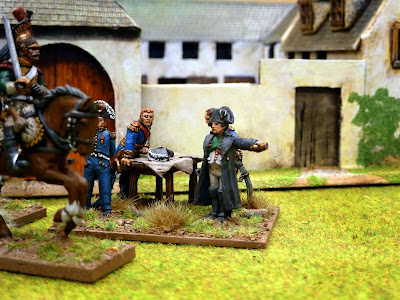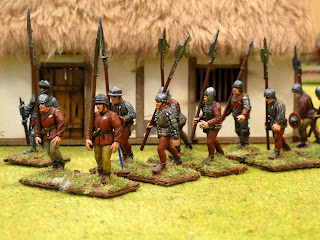ATTACCO ALLA CONTEA
Introduzione
Al suo ritorno Sam trovò l’intero villaggio in piedi. Oltre a parecchi ragazzi più giovani, più di cento vigorosi Hobbit erano già radunati, muniti di asce, pesanti martelli, lunghi pugnali e grossi bastoni; alcuni avevano degli archi. Ne arrivarono molti altri dalle fattorie adiacenti.
I banditi arrivarono dalla Via Orientale, e senza fermarsi presero la Via di Lungoacque che saliva fiancheggiata da latri argini sormontanti da piccole siepi. Dopo una svolta, a un paio di centinaia di metri dalla strada maestra, incontrarono una robusta barricata fatta di vecchi carri capovolti.
Gli hobbit del paese avevano veduto Saruman uscire da una della capanne. Quando udirono l’ordine di Frodo: “Non lo lasciate andare! Uccidetelo! E’ un farabutto e un assassino. Uccidetelo!”. Saruman guardò i loro visi ostile e sorrise: “Uccidetelo” li schernì “Uccidetelo, se credete di essere in numero sufficiente, miei coraggiosi Hobbit!”. Si tenne eretto e li fissò con i suoi occhi neri. “Ma non crediate che quando ho perduto tutti i miei beni abbia perduto anche tutti i miei poteri! Chi mi colpirà sarà maledetto per sempre. E se il sangue macchierà la Contea, la vedrete appassire e non potrete far nulla per sanarla!”
[Copyright Il ritorno del re – JRR Tolkien]
Game system: Il signore degli
anelli
Battle setup:
Lo scenario è stato creato da Biagio F. e Giancarlo M., entrambe membri
della Piccola Armata, che si sono liberamente ispirati al libro di Tolkien e
più precisamente al ritorno degli Hobbit nella Contea. Lo scontro si sviluppa
su tre scenari differenti:
Lato Sud: un gruppo di Hobbit comandati da Merry e Pipino cerca di
raggiungere la Contea ma viene contrastata da due Spettri ed un gruppo di goblin.
Lato Est: cavalca lupi, un Troll e dei warg tentano di ricongiungersi a Saruman passando attraverso un bosco vigilato da Dunedain e da un Ent
Lato Nord: La contea
Obiettivi secondari:
Lato Sud
Male: rallentare gli hobbit ed uccidere Pipino e Merry
Bene: impedire che Saruman possa raggiungere il lato Sud ed uscire
dalla mappa
Lato Est:
Male: attraversare il fiume e raggiungere Saruman
Bene: eliminare i dannati orchetti
Obiettivo primario:
Male: Eliminare Sam, Pipino, Frodo e Merry oppure far uscire Saruman
dal lato sud
Bene: Impedire che Saruman possa raggiungere il lato sud
Regole speciali: in fase di
deployment iniziale l’Ent può essere nascosto in 3 possibili ubicazioni
all’interno della boscaglia sul lato Est della mappa
Deployment e Map
Scala delle miniature: 28 mm
Battle report
La disposizione iniziale
Abbiamo utilizzato delle carte per indicare i tre possibili luoghi in
cui l’ent si “nasconde”. Il termine “nasconde” è doverosamente tra virgolette
considerando che il luogo in cui si deve occulate è un bosco.
I warg ed i cavalca lupi penetrano nel bosco sul lato Est. L’ent è
troppo distante per poter intervenire
Quattro Cavalca lupi riescono a raggiungere il fiume. Uno purtroppo
affoga. Il Troll rimane in retroguardia ad impegnare i Dunedain.
Sul lato sud gli Spettri cercano di rallentare gli Hobbit
Nella Contea gli Hobbit aspettano l’arrivo dei furfanti dietro una
barricata ma …
… i cattivi son ormai sulla Via Orientale
Gli spettri paralizzano con le loro magie diversi nemici ma i goblin
non riescono ad avere la meglio … gli hobbit avanzano.
Lo scontro nella Contea prosegue
Gli arcieri hobbit riescono a fare molte vittime tra i furfanti ma,
grazie all’arrivo di due cavalca lupi i soldati del Male arrivano alle
barricate. Solo grazie ai due eroi hobbit il bene riesce a resistere. Maggot
viene ferito e deve utilizzare tutti i suoi punti fato per non cadere
A sud gli Spettri riescono a raggiungere Merry e Pipino. Uno degli
spettri riesce a stordire Pipino ma l’intervento di un guarda contea vanifica
il suo attacco.
Il Troll elimina diversi dunedain cercando di coprire la fuga di
Saruman ma viene raggiungo dall’Ent …
… che lo elimina in un solo turno
Per Saruman non c’è più scampo
Saruman rise. “Tu fai quello che dice Sharkey, vero, Verme? Ebbene ora ti dice: seguimi!”. Gli sferrò un calcio in pieno viso e Vermilinguo si voltò e lo seguì. Ma improvvisamente qualcosa scattò in lui; si rizzo a un tratto, estraendo un pugnale nascosto e ringhiando come un cane saltò sulla schiena di Saruman, gli tirò indietro la testa, gli tagliò la gola e corse già per il viale con un grido. Prima che Frodo potesse riprendersi e pronunciare una parola, tre frecce hobbit sibilarono e Vermilinguo cadde morto.
[Copyright Il ritorno del re – JRR Tolkien]
Fine: Vittoria del Bene
Note:
Le miniature sono state dipinte da Giancarlo M. e Biagio F.
Le case degli hobbit sono state integralmente auto realizzate da Biagio F.
Army list
Bene: Popoli liberi
Primo gruppo
Frodo e Sam + Maggot + 9 hobbit miliziani + 6 hobbit arcieri e 3 hobbit
guarda contea
Secondo gruppo
Pipino e Merry + 8 hobbit miliziani + 6 hobbit arcieri e 4 hobbit guarda
contea
Terzo gruppo
1 Ent + 7 dunedain
Male: Forze di Saruman
Primo gruppo
Sharkhey e Verme + 12 furfanti
Secondo gruppo
1 Troll di caverna + 12 cavalca lupi e 6 warg
Terzo gruppo
2 spettri dei tumuli e 12 goblin





















































